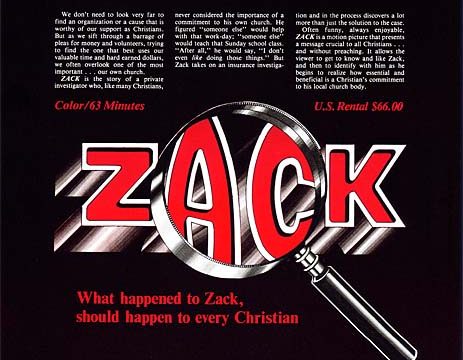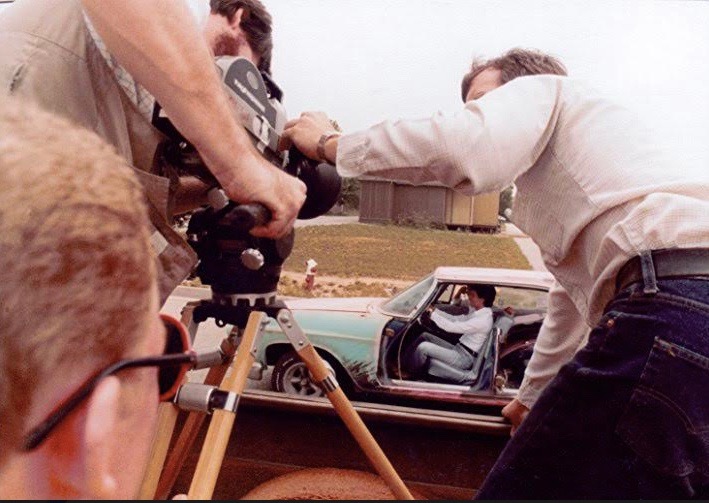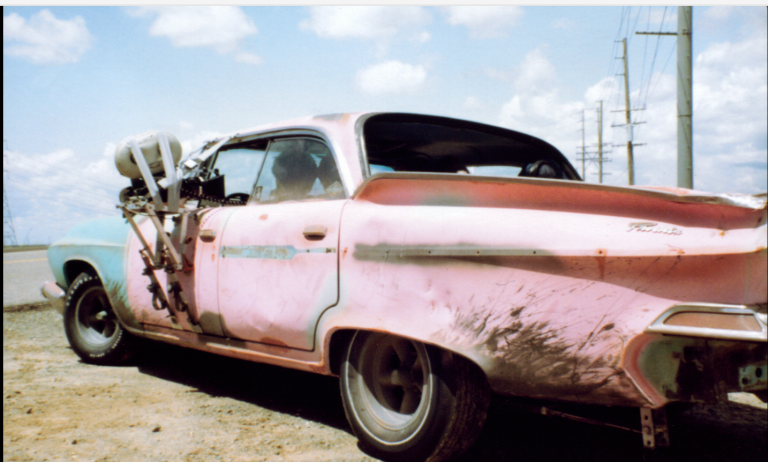Zack is an enigma. At first glance it seems ordinary enough. An old church movie, scooped up by Amazon in some misguided media buy, and now withering away in the bowels of Prime. But very quickly a few details start to gnaw at you. First off, is the fact that this movie has a poster and not just the plain text on a blank background that Amazon’s other unloved and unwanted films receive. In fact, the movie has a full landscape poster, specially formatted for Amazon’s layout. Somebody put that together. Is that a lot of extra work? No, but it’s more than most films get 30 years after they’ve slipped out of print. There’s even a trailer, something Amazon’s not great about providing, and it looks professionally made. You may also notice that the film is boasting a perfect 5 star rating. Zack has been described as “a cross between The Rockford Files and a Ziggy comic” and “relaxing” and has never been described in any other way. Over at IMDB Zack is boasting a blank, having not received a single rating. And yet there are 18 photos connected to the film. And not just screenshots, behind the scenes stuff, that somebody kept for decades, and, when IMDB was finally invented, went and posted.
Somebody out there cares about this movie. But have any of you eagle eyed readers noticed the strangest thing about this picture? Take a closer look at that poster. Notice anything funny? No not the generic logo that is actually a bit of original graphic design, looking much cheaper than just using a production still, but likely costing much more. And not that the film boasts that it’s from the producers of the somehow even more obscure Standing Alone despite also being from the writer/director of Standing Alone, either. No, keep looking.
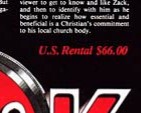
$66 to rent this film! In 1983 dollars, the equivalent of $160 today, to rent a 63 minute movie! Them’s hooker prices! Upscale hooker prices! Also, why 66? Why not 65, or 67? Seems less satanic.
Zack’s opening credits, elegant white lettering over a plain black background set to classical music, tell us exactly what we’re in for- a late period Woody Allen movie. The opening shot is of Zack’s vanity licence plate, and it’s a bold move throwing away any sort of audience sympathy right off the bat. Zack is a private eye trailing a mark, and again- vanity plates, and the score is still classical music. In fact the entire soundscape is classical music. This movie will either have music or it will have sound, never both at once. The music also has minimal relation to the going ons of the story. A scene of Zack brushing his teeth is scored to Flight Of The Valkyries, unwilling to concede the ground to either Francis Ford Coppola or Buggs Bunny.
This scene goes on for awhile, so it’s a good time to look over what we can expect from the plot. Written and directed by William Mingus, “Zack is the story of a private investigator who, like many Christians, never considered the importance of a commitment to his own church.” So he’s got a vanity plate and he works for an insurance company? Watch out John Shaft, there’s a new cat in town. John “Zack” Zachary, a terrible name that the movie is very proud of, is played by Michael David Simms, who is a professional actor. Not “get your picture on imdb” professional, but somebody who got steady work for the next two decades and an adequately convincing human being.
-Wait! But the story continues. Zack returns to his car to find a kid stealing his hubcaps, the music drops out while he confronts him, and picks back up for a pretty long chase sequence. Zack gets his hubcap back, but returns to find his car up on blocks. Which is an old dusty gag, but is adequately executed. We then get that epic teeth brushing scene, and Zack talks to the wife of the man he was tailing. He tells her that her husband had simply been going to an arcade, and she reacts like that was worse than adultery, and you know what- this is a pretty good church joke. It helps that Marnie Crossen, another actress who’s still working, sells the hell out of it.
Zack tries to leave the office, but his car won’t start, and suddenly the pastor of his church pops up. A rather tall bald man in a pink running suit, the pastor is friendly, but vaguely threatening in that hard to pin down Lynchian way, and this whole car trouble thing smells fishy to me. The pastor asks if Zack would be willing to help pour sidewalk for the church this weekend. And wow! That’s way more involved than I was expecting from the pro-volunteer message. This movie ain’t fucking around.
Most movies try and dramatize their message. Want people to volunteer at church? Tell a story about how rewarding volunteer work can be. Somebody joins a work group, falls in love, has a few laughs, finds some meaning and purpose in their life. Simple straightforward propaganda. That’s not the Mingus-method. The Mingus-method of propaganda is to tell the story you want to tell, and then to have characters interrupt every few scenes to nag the audience about your message. It’s less persuasive, but it’s more honest.
Zack takes his car to his friend’s mechanic shop. His, um, black friend. The racial tension in this scene almost derails the entire film. Simms is playing his role broad and smug, and Charles Meshack (another professional actor who was in Commando and Action Jackson) is much more grounded. He seems genuinely busy and annoyed. The two actors keep trying to pull the movie into two different genres, and neither can hide their utter disdain for the other. But we manage to get through it without igniting Helter Skelter and, to be fair, the idea that part of being a good Christian is having friends of different races is pretty hip for 1983. Well, it’s pretty hip for 1973, but it’s still hipper than the median attitude of the target demographic in 1983. Mingus is, however tenuously, still on the side of the Angles here.
Zack borrows a car from Eddie.
A pretty great car. This is a no bullshit real junker, with faded paint and mismatched body panels and an engine that’s giving the sound guy hell. It also has a push button transmission, which was a great big terribly misguided and quickly forgotten idea from Chrysler back in the 50s that anyone who’s 1000 words into an essay on 1983s Zack ought to be able to appreciate. Ambition and personality and foolishness. They get a lot of mileage out this thing too. One of the doors gets knocked off, on camera, by another car, and the whole thing gets smushed by a backhoe. Shockingly good production values for its budget class.
The next scene is going to finally introduce the inciting action. Well, technically the next scene is Zack driving back to the office, then a scene of him taking a phone call and setting a meeting, then a scene of him driving to the meeting… But eventually the music stops and we get to the inciting action, a bit tardy, but otherwise no worse for wear. There’s been a fire, and the police have ruled that it wasn’t arson, but the insurance company wants Zack to look into their client’s finances all the same. “Is there any reason for him to need a large sum of money?” I can’t think of a one. Helping a big insurance conglomerate weasel out of their responsibilities seems decidedly un-Christ-like to me, but I guess that’s a sermon for a different video, because Zack takes the case. The secretary also pops back in to tell the audience that this insurance executive drives a white Buick Riviera. There’s an art to delivering clues in a mystery, a way to slip then into the texture of the story without drawing the audience’s attention. But between the sermons and the concerto we really only have room for this one clue and no red herrings. Of course, by Scooby-Doo rules, our villain really ought to be Pastor Mike, driven to desperation by the lack of church volunteers, but Mingus has too much respect for his audience to lay that kind of guilt trip on us.
Zack returns to his office to find a kid from church waiting for him. A disturbing young man who seems equal parts prepubescent and middle aged. He has a squeaky voice, a disconcerting unblinking confidence, and an unconvincing mechanical charm that will suddenly veer into an almost sexual intensity any time the subject of church volunteering comes up. Jeremy asks for an internship, though it’s an obvious ruse, and Zack begrudgingly agrees, although he warns him, “I think you’ll find this work is a lot more boring than you think it is.” Mingus is nothing if not honest. Jeremy doesn’t mind though, they can pass the time by discussing the importance of volunteering at your local church!
Michael Simms approaches these scenes with a surprising level of authenticity. He drops eye contact, squirms around, tries to change the subject. At one point Jeremy pulls a tiny Bible from his shirt pocket, and Zack laughs in his face. Jeremy doesn’t pick up on this subtle social cue.
There’s a long montage of the two investigating the case, set to still more classical music, and full of helicopter shots. Helicopter shots! Why?! How?! This is also where the car gets demolished, which is done on camera. Mingus might not be a great filmmaker, but he knows enough to put his biggest piece of spectacle at the center of his movie.
In the next scene a beautiful mysterious woman, well, a woman appears in his office in need of help. I kind of feel bad for the movie here. It wants to have a femme fatale, it knows it needs one, but it has to do it without any sex, or desire, or criminality. The woman, Mary, can’t pay, so Zack takes the case pro boner, and no sooner has he begun to investigate her apartme- case than two fake FBI agents bust in asking about the principal of Zack’s other case. Zack recognizes they’re fakes because the background color on the photos on their badges aren’t regulation white, but you may recognize they’re fakes because they’re sporting big bushy porn staches, which is frowned upon at the bureau. This is a little too quick for the cases to collide, and a pretty clumsy collision on top of that. Church movies are always overly reliant on coincidence, always willing to handwave it away as the will of God. Advice to any aspiring screenwriters out there, try not to confuse yourself with God.
Zack’s a pretty bad detective. At one point Jeremy spots a tail. A white Buick Riviera with the same plate, that’s been turning up everywhere and is now parked behind them at a small isolated insurance building. With nothing to go on but the car, the licence plate, and the driver, Zack declares the trail cold, and they return to the office. But even he can spot something fishy about a couple of goons fishing for evidence. This small twinkling of a detective hunch turns to full blown suspicion when the real FBI knocks on his door and explains the case to him. Since our fraudster isn’t Eddie, Jeremy, or Chopin, that only leaves Gordon, the insurance exec from earlier, and Zack agrees to help set him up by pretending to extort a bribe from him. This seems like a pretty big breach of ethics, to me, and doesn’t even lead to a confession, but we hardly have time to play lawyer as we’re back to Zack’s office for one last conversation about volunteer work.
For the life of me I can’t untangle this scheme. Gordon has taken out a $1.2 million dollar policy with his own insurance company under a false name, he has then taken another $200K policy under a different false name. He burns down the building, then clears the second policy to pay out, but collects on the first. He also has hired a private detective to look into his own arson, and hired a couple of goons to harass a former employee, who might have copies of the policy that he’s trying to collect on. This is either exploiting a very specific flaw in early 80s computer networking, or it’s nonsense. Either way, the FBI has been on to him for over a year, which makes Zack’s role in the story completely irrelevant.
All in all I find myself walking away from Zack with quite a bit of affection for the film. It may not be good, but it’s enthusiastically and competently made. And as propaganda it’s refreshingly inoffensive. The film is honest about who it’s audience is and what it’s goals are. It’s not hateful or tribalistic. This subgenre would become more and more exploitative over the following decades, and it’s nice to look back at something sincere, with a message as worthwhile as it is hamfisted. It’s not a movie that I could recommend to anyone, nether a train wreck nor a lost gem, but it’s a movie that’s fully aware of its limitations and still trying to be the best durn movie it can be. And that’s gotta count for something.
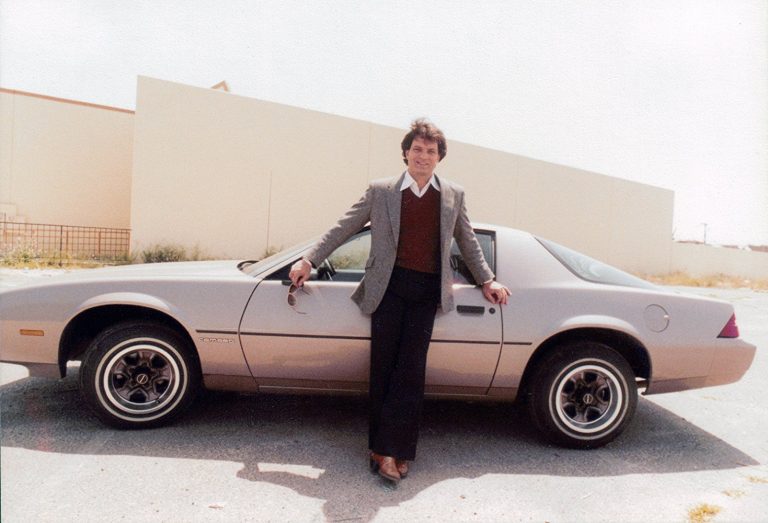
Visit some old people! It sucks, but a little bit of your time can mean a lot to somebody. Tell ‘em Mingus sent you.

